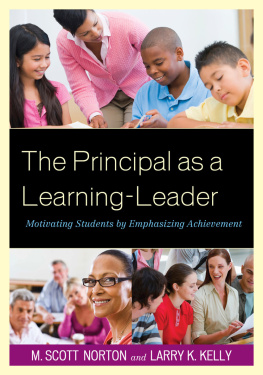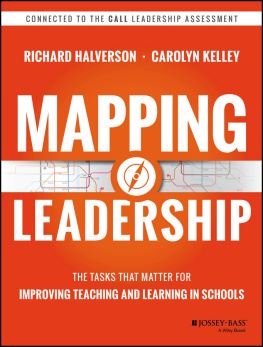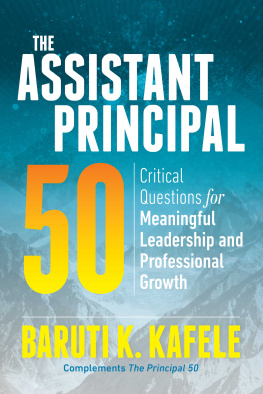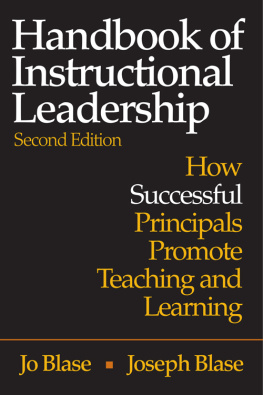The Principal as a Learning-Leader
Motivating Students by Emphasizing Achievement
M. Scott Norton and Larry K. Kelly
Rowman & Littlefield Education
A Division of
Rowman & Littlefield Publishers, Inc.
Lanham New York Toronto Plymouth, UK
Published by Rowman & Littlefield Education
A division of Rowman & Littlefield Publishers, Inc.
A wholly owned subsidiary of The Rowman & Littlefield Publishing Group, Inc.
4501 Forbes Boulevard, Suite 200, Lanham, Maryland 20706
www.rowman.com
10 Thornbury Road, Plymouth PL6 7PP, United Kingdom
Copyright 2013 by M. Scott Norton and Larry K. Kelly
All rights reserved . No part of this book may be reproduced in any form or by any electronic or mechanical means, including information storage and retrieval systems, without written permission from the publisher, except by a reviewer who may quote passages in a review.
British Library Cataloguing in Publication Information Available
Library of Congress Cataloging-in-Publication Data
Norton, M. Scott.
The principal as a learning-leader : motivating students by emphasizing achievement / M. Scott Norton and Larry K. Kelly.
p. cm.
Includes bibliographical references.
ISBN 978-1-61048-806-8 (cloth : alk. paper)ISBN 978-1-61048-807-5 (pbk. : alk. paper) ISBN 978-1-61048-808-2 (electronic)
1. School principalsRating of. 2. Academic achievement. I. Kelly, Larry K., 1936 II. Title.
LB2831.96.N67 2013
371.26dc23
2012030849
 The paper used in this publication meets the minimum requirements of American National Standard for Information SciencesPermanence of Paper for Printed Library Materials, ANSI/NISO Z39.48-1992.
The paper used in this publication meets the minimum requirements of American National Standard for Information SciencesPermanence of Paper for Printed Library Materials, ANSI/NISO Z39.48-1992.
Printed in the United States of America.
Contents
Preface
This book is intended for the school leader that currently is serving as a practitioner in the field. Thus, the book focuses on those individuals in the school who are serving in a leadership role and have faced many of the contemporary problems relative to such matters as underperforming schools, student dropout rates, low student achievement, and student performance accountability. However, those school leaders that are experiencing success in creating a learning culture in their school also will find the book to be beneficial for their continued professional growth. In addition, those individuals who aspire to a career in the principalship will find the information in the book of special value. School boards are making new demands for student learning that commonly are interpreted as student failure is no option, or else!
In most instances, the professional preparation of the principal includes managerial responsibilities related to budgeting, facility planning, personnel administration, and other aspects of organizing and managing the schools operations.
Such preparation might not include sufficient preparation in the areas of student learning, curriculum development, and academic performance assessments. Today, the primary need for school leadership centers on the fostering of student achievement and establishing a learning culture in the school.
The primary purpose of the book is to provide practicing school principals and others who aspire to that role to be able to meet the challenges related to learning leadership. The book serves as a guide for ensuring the accomplishment of the goal of establishing a learning culture in the school. Persons who use the book will gain the knowledge and skills useful in becoming an effective learning-leader. Each chapter presents creative but practical suggestions for achieving that objective.
The book will help the principal answer the following questions: Are you truly a learning-leader? Are your students enrolled in a school with a learning culture? In what ways does your personal behavior demonstrate the traits of an effective learning-leader? Am I doing what truly is in the best interests of each individual student regarding his or her learning achievement? Do I have an organized procedure for assessing student achievement and using data results to change students programs accordingly? Am I able to provide credible evidence that our program of offerings and activities is resulting in continuous student growth?
When you think about or are asked about your personal administrative strengths, does your answer reflect those of a learning-leader? An opportunity for you to assess your learning-leadership is provided at the outset of the book. You can participate in activities being discussed in the chapters and test the many recommendations for improving student learning along the way.
The books special features include the fact that the book is reader friendly. It provides a clear definition of learning-leadership and how it varies from the definition of an instructional leader. The focus on program practices that are in the best interests of students and support successful learning results is present throughout the book. Snapshots of effective practices, as reported by successful learning-leaders, are presented in each chapter. Engaging and reengaging students in the learning process are considered one of the books special features. The book presents several models for the school principal to consider for establishing a learning culture in the school and school community.
The importance of accountability, partnerships, and collaboratives is considered in-depth. Strategies for demonstrating accountability, the special needs of a successful school partnership, and models for implementing these important program provisions are given special attention.
The importance of establishing a healthy climate, as it relates to the improvement of student achievement in the school, is given primary consideration. We submit that one of the key factors for realizing improvements in student achievement is that of establishing positive relationships among teachers, students, administrators, and stakeholders in the school community.
Tools and techniques are provided that enable the school principal to foster a learning climate that engages all students, teachers, staff personnel, parents, and others in the learning process. How successful principal learning-leaders work to foster a learning-centered culture in the school is emphasized throughout the book.
Introduction
School leaders today are pressed to provide evidence of continuous student success relative to academic achievement. Effective schools are judged primarily by student academic test results in the key subject areas of mathematics, science, reading, and English studies. The schools quality rating no longer is based primarily on such provisions as the schools comprehensive curriculum provisions, teacher performance measures, or student behavioral data. Rather, student academic results as measured by federal, state, and local standards commonly determine the fate of the school, the school leaders, and the schools teachers.
It isnt that a good school public relations program, winning sports program, or student retention rate is not important, it is just that these factors tend to fade into the background when the academic achievement data results fall below the achievement benchmarks expected of student learners. When the question is asked, What is the primary role of the school principal, answers such as to plan and organize the schools program, to develop a program of effective public relations, or to provide professional growth opportunities for the faculty and staff fall short of todays accountability demands. Without question, the school principals major role is to serve as the learning-leader of the school and to develop a learning culture within the school community.











 The paper used in this publication meets the minimum requirements of American National Standard for Information SciencesPermanence of Paper for Printed Library Materials, ANSI/NISO Z39.48-1992.
The paper used in this publication meets the minimum requirements of American National Standard for Information SciencesPermanence of Paper for Printed Library Materials, ANSI/NISO Z39.48-1992.